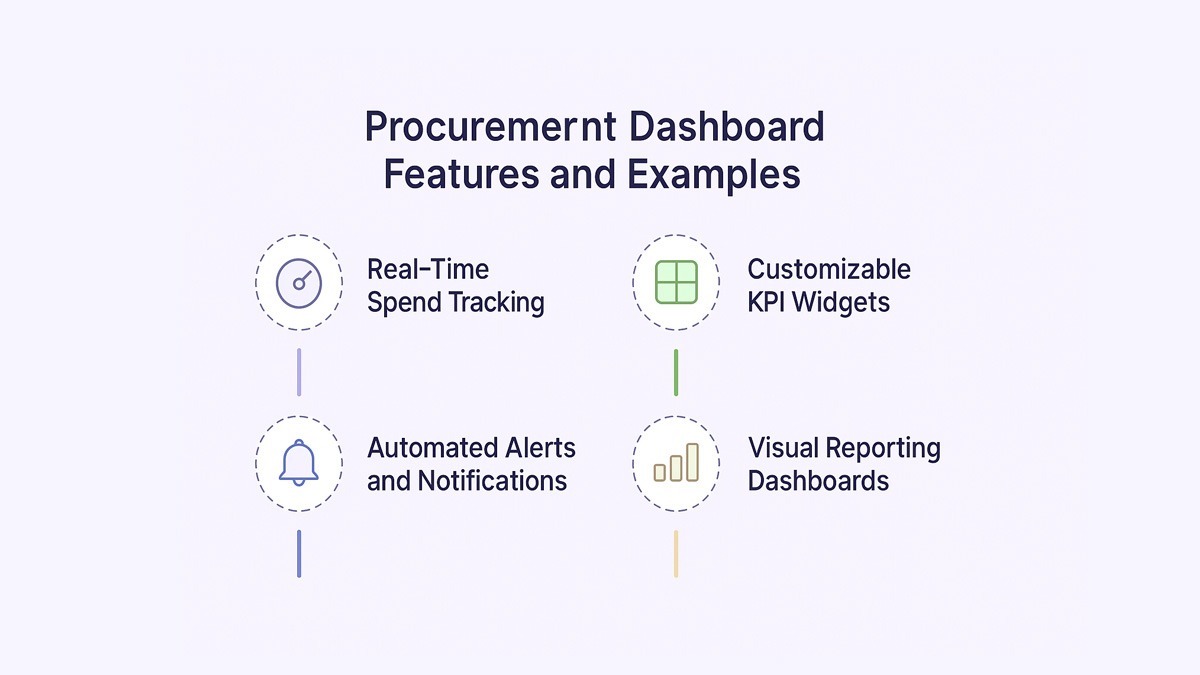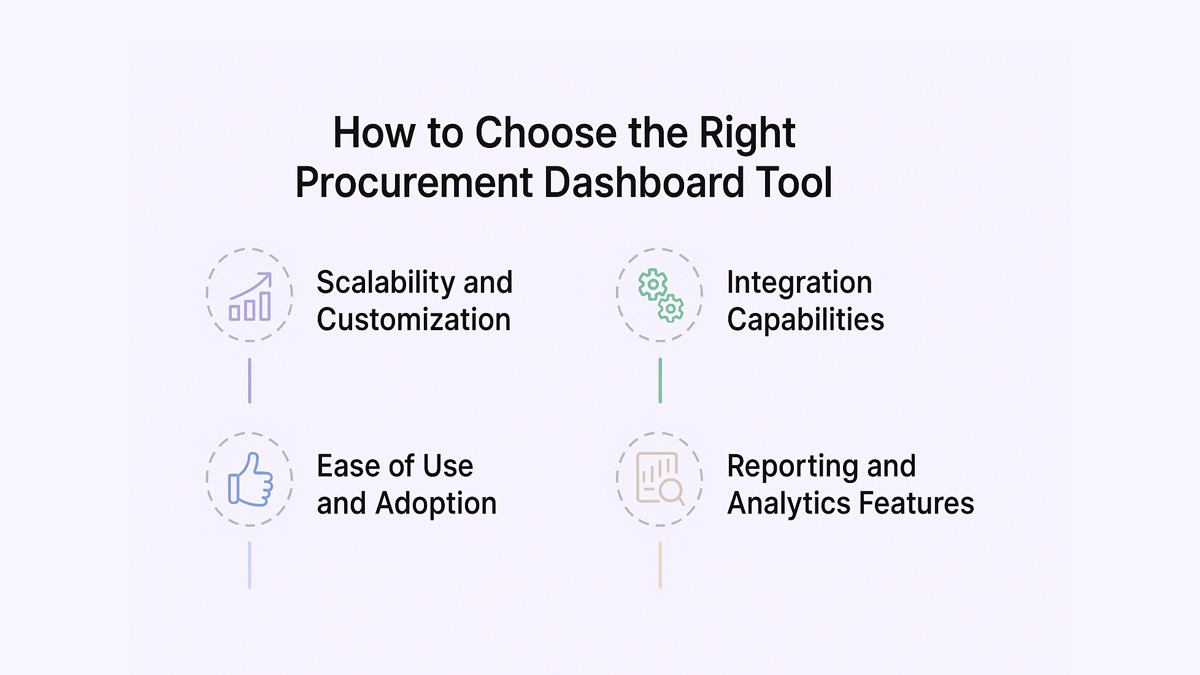

Procurement Dashboard: Why It Matters and How the Right One Can Transform Your Process

Procurement Dashboard: Why It Matters and How the Right One Can Transform Your Process
Explore how procurement dashboards drive smarter decisions with spend visibility, supplier tracking, and real-time performance insights.


“Nearly 60% of finance and procurement leaders say their biggest challenge is pulling accurate data when they need it most.” It’s no surprise with scattered reports, manual tracking, and siloed tools, visibility is often the first casualty of a busy procurement cycle.
Imagine this: you’re in a boardroom, and the CFO asks for a quick overview of cost savings, supplier performance, and contract renewals. You have minutes to respond, but the numbers live across spreadsheets and emails. It’s stressful and it happens every day. That’s why more teams are turning to procurement savings dashboards to bring real-time, decision-ready data into one clear view.
What is a procurement savings dashboard?
A procurement savings dashboard is a visual tool that displays key metrics like spend, supplier performance, and contract status in one view. It helps procurement teams track savings, improve efficiency, and make faster data-driven decisions by turning complex data into clear, actionable insights.
Why are procurement savings dashboards Important
procurement savings dashboards aren’t just nice-to-haves - they’re central to running a streamlined, efficient, and accountable procurement function. They take what used to be fragmented data across teams and tools and unify it into an easy-to-digest snapshot. With rising expectations on procurement teams to deliver both savings and strategy, this clarity is no longer optional.
Dashboards bring transparency to spend, ensuring leadership can make informed decisions without chasing data. They also help flag inefficiencies early - whether it’s a bottleneck in the purchase order cycle or a drop in supplier reliability. With procurement taking center stage in strategic planning, dashboards enable faster insights and better forecasting.
Common Procurement Challenges Dashboards Solve
Even the most well-intentioned procurement teams hit roadblocks - dashboards help remove many of them. Here’s how:
Lack of Spend Visibility
Without a dashboard, spend data is often trapped in spreadsheets or siloed systems. Dashboards centralize this data, offering a bird’s-eye view of spend trends, categories, and vendor allocation in one glance. Teams can also monitor inventory levels to prevent overstocking or running out of critical supplies.
Manual Data Consolidation
Manually gathering data from ERPs, emails, and reports eats up valuable time. Dashboards automate this, pulling in real-time data from various sources and cutting down reporting hours. This streamlines data collection and eliminates manual reporting tasks. It also helps improve asset management by mapping purchases to usage and lifecycle tracking.
Delayed Decision Making
Decision paralysis often stems from slow or incomplete data. Dashboards speed up insight generation, helping procurement leaders respond quickly to price changes, supplier risks, or urgent buying needs. Teams can also monitor shipping costs to reduce logistics overhead.
Difficulty in Tracking Vendor Performance
When supplier scorecards live in separate tools - or worse, not at all - it’s hard to compare performance.
Dashboards offer a unified vendor view that includes delivery timelines, quality ratings, and risk scores. Tools with good search engine optimization make it easier to locate vendor data quickly.
Procurement savings dashboard Features
procurement savings dashboards come packed with features that make data both actionable and accessible. Here are some key features and examples of how they work in real-world setups:

Real-Time Spend Tracking
Track your procurement spend across departments, vendors, and categories. Real-time visibility ensures you stay within budget and spot anomalies early.
Customizable KPI Widgets
Whether you want to monitor supplier delivery rates or contract renewal timelines, widgets allow teams to customize dashboards to focus on the KPIs that matter most. Keeping track of key performance indicators ensures procurement efforts stay aligned with strategic priorities.
Automated Alerts and Notifications
Dashboards can trigger alerts for contract expirations, budget overruns, or unusual spending patterns - giving procurement teams time to act before issues escalate. They can also help monitor contract performance over time by surfacing key compliance gaps. Integrating product information management can further ensure data consistency across suppliers and catalogs.
Visual Reporting Dashboards
Pie charts, trend lines, and heat maps bring procurement data to life. These visual cues make it easier for stakeholders to spot issues without deep analysis. They make it easier to communicate performance metrics with non-procurement stakeholders like finance or executive leadership. Dashboards also standardize performance reporting for easier cross-functional alignment.
How to Choose the Right procurement savings dashboard Tool
Not all dashboards are created equal. If you’re evaluating tools, make sure they tick these boxes:

Scalability and Customization
As your procurement function grows, so should your dashboard. Choose a tool that can scale with your team, and offers customizable layouts and widgets to reflect your unique KPIs.
Integration Capabilities
Your dashboard should play well with other systems - like ERPs, contract management tools, and inventory platforms. Seamless integration means fewer data gaps and more real-time accuracy.
Ease of Use and Adoption
The most powerful dashboard is useless if no one uses it. Look for intuitive UI, drag-and-drop features, and role-based access so it fits naturally into your team’s daily workflow.
Reporting and Analytics Features
Good dashboards don’t just show you numbers - they help you make sense of them. Features like trend analysis, predictive insights, and drill-down capabilities transform raw data into strategic guidance. Some platforms go further by generating automated insights to surface cost inefficiencies.
Key Procurement Reports Generated by Dashboards
Procurement dashboards bring structure to reporting by turning raw data into clear, actionable views. Here are six key procurement reports every team should track:
1. Spend Reports: Spend reports show how much your organization spends, with whom, and on what. They highlight cost trends, identify duplicate purchases, and reveal opportunities to save.
2. Supplier Reports: Supplier reports track vendor performance across metrics like delivery time, quality, and pricing. These insights help teams strengthen relationships and hold suppliers accountable.
3. Category Reports: Category reports group spending by product or service type. They help identify which categories consume the most budget and where consolidation or negotiation could reduce costs.
4. Budget Reports: Budget reports compare actual spending against planned allocations. They give finance and procurement leaders an instant view of where spend is on or off track.
5. Contract Reports: Contract reports summarize key contract details, renewal dates, and compliance terms. They reduce the risk of missed renewals and ensure teams stay within agreed terms.
6. Compliance Reports: Compliance reports ensure all purchases meet internal policies and external regulations. They flag exceptions early so teams can maintain audit readiness and accountability.
Top Procurement KPIs to Track in Your Dashboard
Tracking the right procurement KPIs can turn your dashboard from a static report into a powerful decision-making tool. Here are the top metrics that should be on every procurement savings dashboard:
Cost Savings Achieved
This KPI reflects the amount saved through negotiations, strategic sourcing, or vendor consolidation. Monitoring Purchase Price Variance highlights fluctuations that may signal pricing issues or contract lapses. It’s a direct measure of procurement’s contribution to the bottom line.
Purchase Order Cycle Time
Measures the time from requisition to PO approval. Shorter cycles indicate a more efficient procurement process and reduce delays in project execution. Automation tools can further streamline purchase order creation and minimize bottlenecks.
Supplier Performance
Track metrics like on-time delivery rate, quality issues, and responsiveness. Monitoring the Supplier Defect Rate can uncover recurring issues in product or service delivery. These are foundational for effective supplier relationship management across departments. High-performing suppliers have a direct impact on customer satisfaction outcomes. This KPI helps identify reliable vendors and highlight those that may need to be reassessed. Factoring in the cost of goods sold helps contextualize procurement’s financial impact.
Compliance Rate
Are teams using preferred suppliers? Are purchases happening through approved channels? This KPI measures how closely procurement activities follow policy.
Spend Under Management
Reflects the percentage of total spend that goes through the procurement process. The higher this number, the more influence procurement has on organizational spending. Increasing procurement spending visibility leads to better budget allocation and vendor accountability.
Contract Renewal Timeliness
Tracks how effectively your team is managing contract timelines. Missed renewals often lead to auto-renewals or missed negotiation windows.
Supplier Risk Score
An aggregate score based on financial stability, performance history, and compliance risk. Helps identify suppliers that could disrupt business continuity. Early detection of issues is key to proactive risk mitigation strategies.
Invoice Match Rate
How many invoices match the corresponding POs and receipts? A high match rate reduces the risk of overpayment and accounting issues.
Maverick Spend Percentage
Measures unauthorized or off-contract spend. This helps reduce leakages and ensure negotiated terms are being utilized.
Procurement ROI
This KPI compares the total value delivered by procurement against the cost of running the procurement function. It demonstrates strategic impact and justifies investments.
Essential Procurement Savings Dashboard Examples
Procurement dashboards go beyond simple spend tracking. They connect cost, supplier, and contract data to give teams a complete view of performance. Here are five essential types every procurement team should use.
Procurement Savings Dashboard
A Procurement Savings Dashboard highlights total cost savings achieved through better sourcing, negotiation, and vendor consolidation. It also measures ROI on procurement initiatives, helping finance leaders track real impact and validate investments.
Supplier Performance Dashboard
The Supplier Performance Dashboard monitors vendor reliability through on-time delivery (OTD), quality scores, and risk ratings. It helps procurement teams evaluate supplier performance, identify potential issues early, and maintain healthy partnerships.
Maverick Spend Dashboard
A Maverick Spend Dashboard focuses on compliance rates and unauthorized purchases made outside approved processes. It reveals where spending deviates from policy, allowing teams to control leakage and reinforce purchasing discipline.
Purchase Dashboard for Order Tracking
The Purchase Dashboard for Order Tracking visualizes purchase order (PO) cycle times and project pipelines. It gives managers a clear view of order progress, bottlenecks, and delivery timelines to improve efficiency across teams.
Contract Management Dashboard
A Contract Management Dashboard centralizes contract data, highlighting renewal timeliness and contract coverage. It ensures no renewals are missed, improves visibility across vendors, and helps track contract performance against compliance goals.
How Spendflo Helps With Procurement Savings Dashboard Optimization
Procurement leaders often spend hours pulling reports from different tools just to answer one question: Where is our money going? The lack of visibility slows decisions, increases overspend, and leaves teams reacting instead of leading.
A fast-growing tech company faced the same challenge before switching to Spendflo. By consolidating all their spend, vendor, and contract data into a unified dashboard, they gained full visibility across procurement and cut their software costs by 28% in just one quarter.
The real pain isn’t just the time lost, it's the missed savings hiding in scattered data. Spendflo turns that complexity into clarity with real-time, actionable insights that help teams make confident decisions, faster.
If your procurement process still runs on spreadsheets and guesswork, it’s time to change that. Book a demo with Spendflo and see how you can transform reporting chaos into measurable savings.
Frequently Asked Questions on Procurement Dashboards
What is the difference between a procurement dashboard and a spend dashboard?
A procurement dashboard provides a holistic view of procurement operations, including vendor performance, purchase orders, and contract timelines. A spend dashboard, on the other hand, focuses primarily on analyzing financial data related to expenditures.
How do procurement dashboards improve decision-making?
They centralize real-time data, allowing procurement teams to spot trends, track KPIs, and act quickly. This helps reduce delays, identify cost-saving opportunities, and align purchasing with business goals.
Can small businesses benefit from using procurement dashboards?
Absolutely. Even small teams gain value from dashboards through better visibility, fewer manual errors, and quicker approvals - saving time and money across the board.
What are common mistakes to avoid when setting up a procurement dashboard?
Avoid overloading the dashboard with too many metrics, ignoring user experience, and failing to update data sources regularly. A clean, relevant, and real-time dashboard is far more effective than a cluttered one.
What is a supplier portal and how does it help?
A supplier portal is a digital platform where vendors can manage orders, submit invoices, and track performance. It streamlines communication, improves transparency, and supports better supplier evaluation and collaboration.
How does strategic sourcing support better contract negotiation?
Strategic sourcing enables procurement teams to analyze spend data and vendor capabilities, which leads to stronger contract negotiation outcomes. It also helps in identifying volume discounts and optimizing the procurement lifecycle.
Why are supplier-managed catalogs useful in procurement?
Supplier-managed catalogs reduce manual product data entry and allow for more accurate product listings. They also support sustainable procurement by enabling buyers to prioritize eco-friendly options within purchasing policies.
What is the role of ESG indicators in procurement dashboards?
ESG indicators help procurement teams track environmental, social, and governance performance across their supply base Dashboards that include these metrics promote responsible sourcing and help meet compliance standards.
How can procurement dashboards improve category management?
Dashboards provide real-time insights into indirect categories, billing rates, and price drivers. This transparency supports better category management, enabling smarter risk mitigation across business units.










.png)




.png)










.avif)





